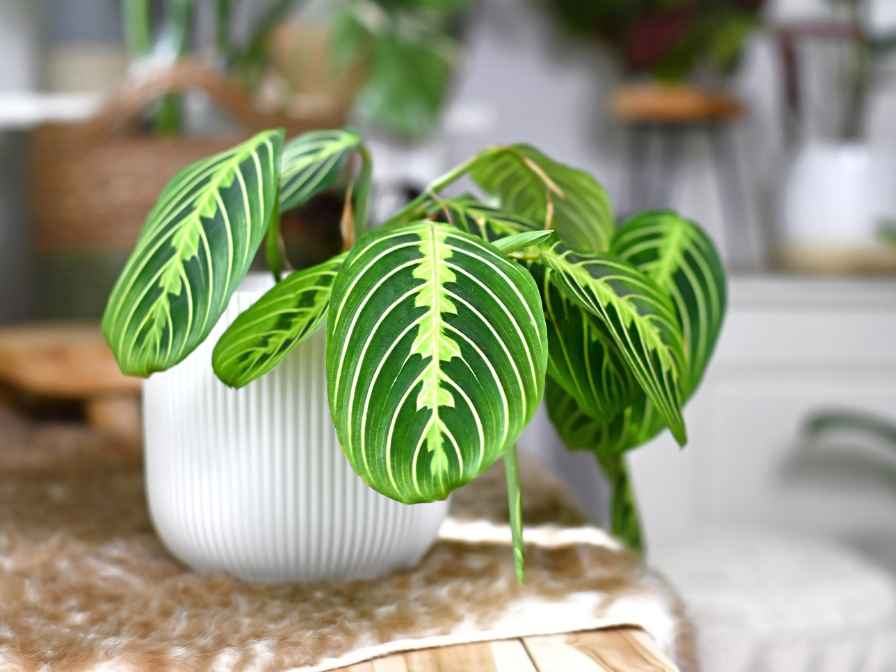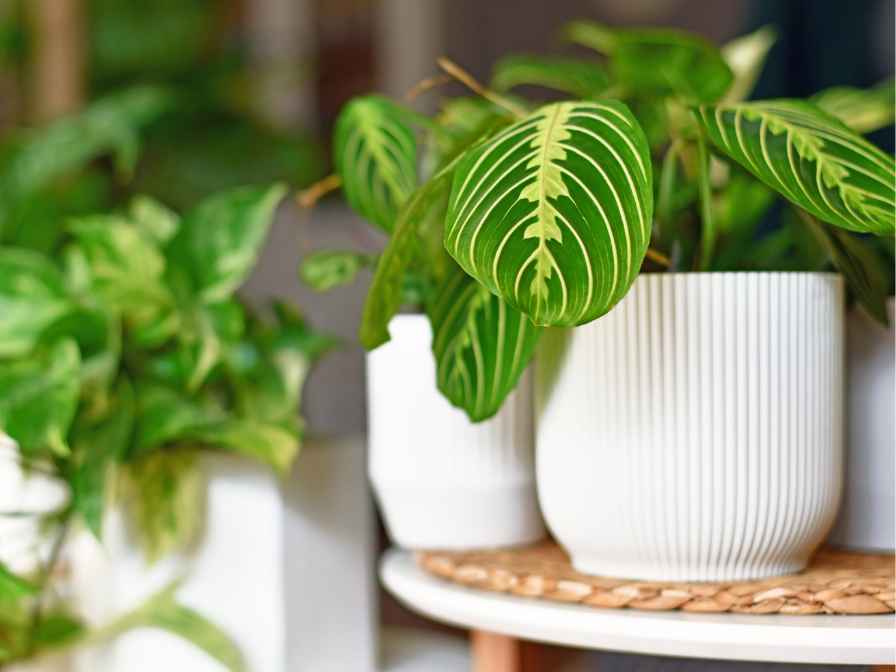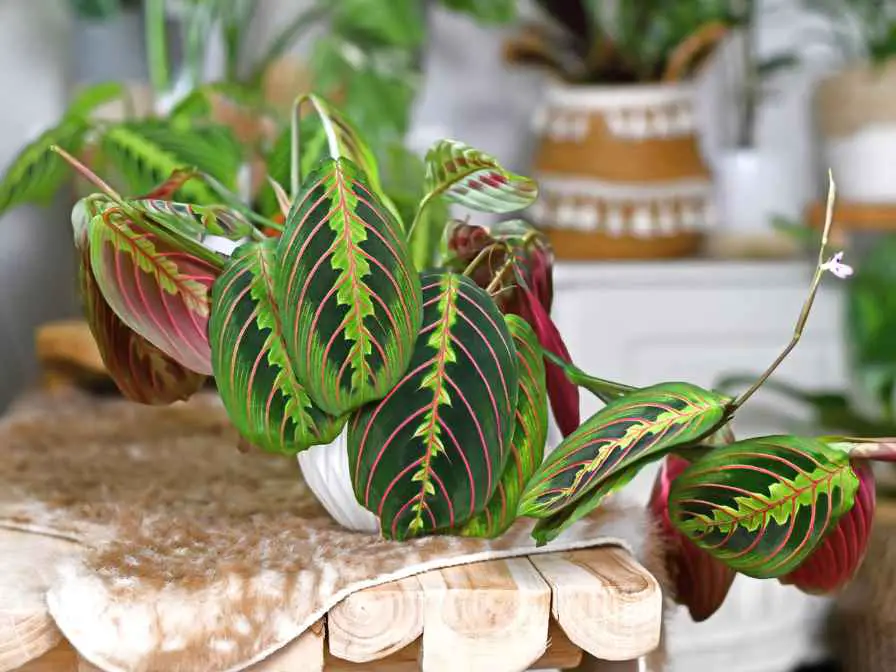When searching for indoor potting plants, gardeners do go for plants or flowers which have specific qualities. These plants should be easy to care for, they can be grown and maintained in pots easily, these plants should also add ornamental value to indoor space as well.

Well, your search is over. Because the plant is here. The prayer plant is known for its ornamental value. But it has requirements regarding lighting, otherwise, it is quite easy to plant and care for. That’s why we are going to tell you about the prayer plant lighting guide.
Prayer plant
The Prayer Plant is a common houseplant known for its distinctive leaves that fold up at night, resembling hands in prayer. It is scientifically known as Maranta Leuconeura and is native to the tropical rainforests of South America
The plant requires warm temperatures, high humidity, and bright but indirect light to thrive. It is known for its attractive foliage, which can range in color from green to dark red. The plant produces small, inconspicuous flowers, and is relatively easy to care for, making it a popular choice for beginners and experienced gardeners alike.
These plants are non-toxic. These are safe for pets and children. These plants don’t need much space and are available in a variety of colors.
The Prayer Plant has several benefits when grown as a houseplant
Improved air quality
Like many other plants, the Prayer Plant helps to purify the air by removing harmful pollutants and releasing oxygen. It absorbs and keeps harmful pollutants out of indoor settings. You can plant it for that purpose also.
Reduced stress and anxiety
The presence of plants has been shown to have a calming and soothing effect on people, reducing stress and anxiety levels. The same goes for the prayer plant. Even it symbolizes gratitude which helps the person stay positive.
Increased humidity
The Prayer Plant is known for its high humidity requirements, and its transpiration process helps to increase the moisture content in the air, providing relief for dry skin and respiratory conditions. This quality makes it a perfect indoor plant.
Aesthetic appeal
With its distinctive foliage and attractive colors, the Prayer Plant is a visually appealing addition to any room, adding a pop of green and making it a great option for home décor. You will see these plants in many indoor homes, and corporate settings as well.
Ease of care
The Prayer Plant is a relatively low-maintenance plant that is easy to care for, making it a great option for those who do not have a lot of experience with gardening. This makes it easy. You get most of the benefits with minimal effort.
How to plant prayer plants?

Choose the right pot. This selected pot should have holes. These drainage holes will get the excess water out of the pot. This pot should be slightly larger than the current pot of your plant and will provide enough space for the roots to grow.
Prepare the soil well. Use a well-draining potting mix designed for tropical plants or a mix of equal parts peat moss, perlite, and vermiculite. You can add organic compost to meet the requirements of nutrients.
Now you have got the soil and pot, right? Plant the prayer plant in it. Tap the soil gently around the plant. Place the plant in the pot. Carefully remove the plant from its current pot and loosen any tangled roots. Place it in the center of the new pot and fill in around the roots with soil.
After planting, water your Prayer Plant thoroughly to settle the soil and remove any air pockets. Drain any excess water that collects in the saucer. The Prayer Plant prefers bright but indirect light. Place it near a bright window but out of direct sunlight, which can scorch its leaves.
The Prayer Plant prefers high humidity and moist soil. Keep the soil consistently moist but not waterlogged. Consider using a humidity tray or a humidifier to increase humidity levels.
Now you have planted the prayer plant. Actually important part starts here. It’s because many people don’t take lighting into consideration. That’s what we are going to tell you.
Prayer plant lighting guide
The Prayer Plant requires bright but indirect light to thrive. It can tolerate low light levels, but it may grow more slowly and have less vibrant foliage. Direct sunlight can scorch the leaves, so it’s best to place it near a bright window but out of direct sunlight.
Direct sunlight may damage the plant. That’s why it is recommended to place the prayer plant in indirect sunlight. It is important to consider because otherwise, you might end up losing your plant. The ideal lighting conditions for the Prayer Plant are:
Bright, indirect light
The Prayer Plant prefers bright but indirect light, which can be achieved by placing it near a bright window but out of direct sunlight. Bright sunlight will help the prayer plant grow steadily. Placement of the plant can be alongside the window
As the prayer plant is planted in the pots. It can be easily moved to partially shady areas.
Avoid direct sunlight
Direct sunlight can scorch the leaves, so it’s important to protect the plant from direct sun exposure. So keep it away from direct sunlight.
Provide additional lighting
If your home does not receive enough natural light, consider using artificial lights, such as fluorescent lights or LED grow lights, to supplement the plant’s lighting needs. Make sure the lights are enough to maintain the light requirements of the prayer plants.
It’s important to monitor your Prayer Plant’s foliage to ensure it’s receiving the right amount of light. If the leaves start to yellow, they may be getting too much light, while if the leaves start to look pale, they may not be getting enough light. Adjust the lighting conditions as needed to keep your plant healthy and thriving.
Taking care of prayer plant

The prayer plant (Maranta leuconeura) is a popular houseplant that is known for its attractive, green, and marbled leaves that fold upward at night, resembling praying hands. To care for your prayer plant you can consider some of the following efforts:
Water Requirements
Water the plant regularly, allowing the soil to dry out slightly between watering. Over-watering can cause root rot, so be sure to avoid keeping the soil consistently moist. You can check the upper layer of the soil, if it is dry water it.
Humidity requirement
The prayer plant prefers a humid environment, so consider misting the leaves regularly. Also, use a well-draining potting mix. To keep the humidity intact, you can keep the plant pot on the tray filled with pebbles and water.
Temperature & Fertilizer requirements
The prayer plant prefers a warm and stable temperature between 60-85°F (15-30°C). Feed your prayer plant monthly with a balanced liquid fertilizer during the growing season (spring and summer). Provide balanced fertilizers. So that excess of any one fertilizers may not damage the prayer plant.
In short, the prayer plant is such an indoor pant that can be planted for many reasons, with great ease. Moreover, as natives of the Americas, we can simply plant it. We don’t have to create a special climate for it. We just have to take care of the light requirements otherwise you are good to go.

